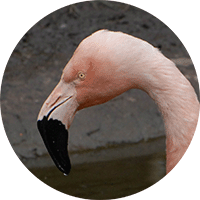Chilean Flamingo
The Chilean Flamingo (Phoenicopterus chilensis). Read in Spanish
Appearance: Chilean Flamingos are easily recognized by their striking appearance. They have pink plumage with darker pink primary and outer secondary feathers, giving them a distinct coloration. Their legs are long and pink, and their bills are light gray with a black tip. They are one of the smaller species of flamingos, reaching heights of around 3 to 4 feet.
Habitat: Chilean Flamingos typically inhabit shallow alkaline or saline lakes, lagoons, and estuaries. These wetlands provide rich sources of food such as algae, invertebrates, and small crustaceans which make up the bulk of their diet. They are known to migrate between different habitats depending on food availability and breeding conditions.
Behavior: Chilean Flamingos are social birds that often form large flocks, especially during the breeding season and migration. They are known for their synchronized group movements and distinctive vocalizations. They are also known for their elaborate courtship displays, which involve synchronized group dances and vocalizations.
Breeding: Breeding colonies of Chilean Flamingos are established in suitable wetland habitats. They build mud nests in shallow waters to protect their eggs from predators. Both male and female flamingos take turns incubating the eggs. After the chicks hatch, they are cared for by the parents and the entire flock, known as a creche.
Conservation Status: The Chilean Flamingo is classified as 'Near Threatened' on the IUCN Red List of Threatened Species. The main threats to their population include habitat loss due to agriculture, mining, and urban development, pollution of their wetland habitats, disturbance by human activities, and climate change impacting their food sources and nesting sites.
Distribution
The Chilean Flamingo (Phoenicopterus chilensis)
Pacific Region: Along the western coast of Colombia, in areas such as Chocó Department, and Nariño Department there are coastal lagoons and estuaries where Chilean flamingos could potentially be found.
Taxonomy
The Chilean Flamingo (Phoenicopterus chilensis)
- Kingdom: Animalia
- Phylum: Chordata
- Class: Aves (Birds)
- Order: Ciconiiformes
- Family: Phoenicopteridae
- Genus: Phoenicopterus
- Species: Phoenicopterus chilensis
Vocalization
The Chilean Flamingo (Phoenicopterus chilensis) is known for its distinctive vocalizations, which play an important role in communication within the flock, particularly during courtship displays, mating rituals, and group movements.
- Hooting Calls: Chilean Flamingos produce a deep, resonant hooting call that is often heard during courtship displays and group activities. This call is characterized by its melodic and rhythmic nature, creating a harmonic chorus when produced by a flock of flamingos.
- Trumpeting Calls: Flamingos can also emit a loud, trumpeting call that is used to establish territorial boundaries, warn of potential threats, or signal alarm within the flock. This call is powerful and can be heard over long distances.
- Grunt-like Calls: In addition to their hooting and trumpeting calls, Chilean flamingos may also produce grunt-like vocalizations that convey different meanings depending on the context. These grunts are often used as contact calls between individuals in the flock.
- Chorus Singing: During synchronized group movements or courtship displays, Chilean flamingos may engage in chorus singing where multiple individuals vocalize together, creating a harmonious and coordinated vocal performance that is both visually and audibly striking.
- Communication and Social Bonding: Vocalizations play a crucial role in the social dynamics of Chilean flamingos, helping to maintain group cohesion, establish hierarchies within the flock, and strengthen social bonds between individuals.








